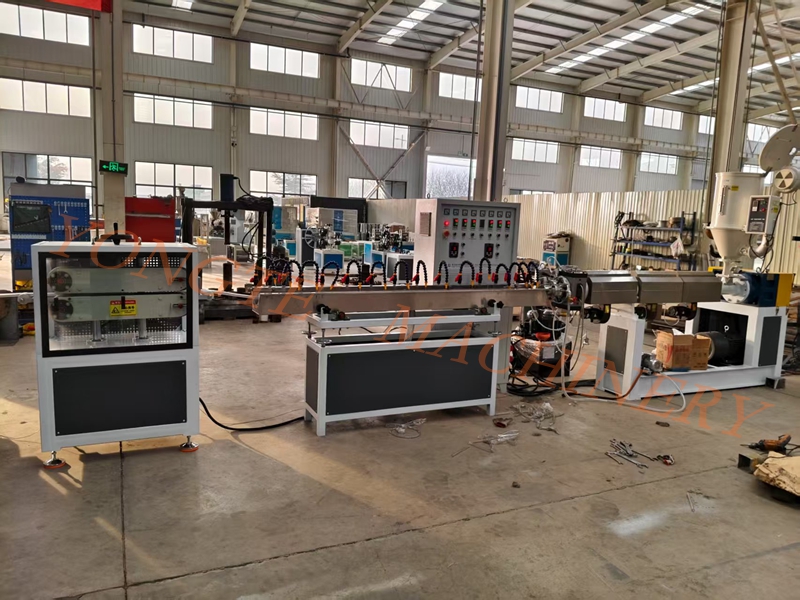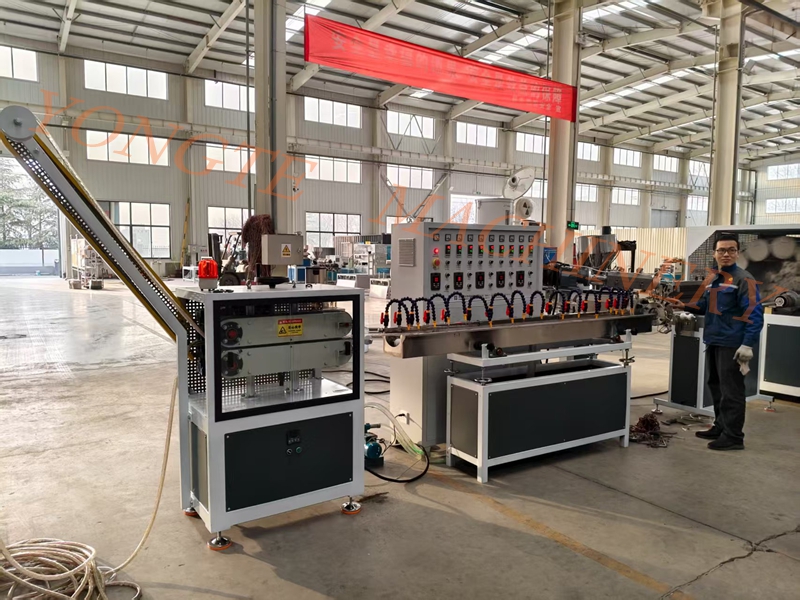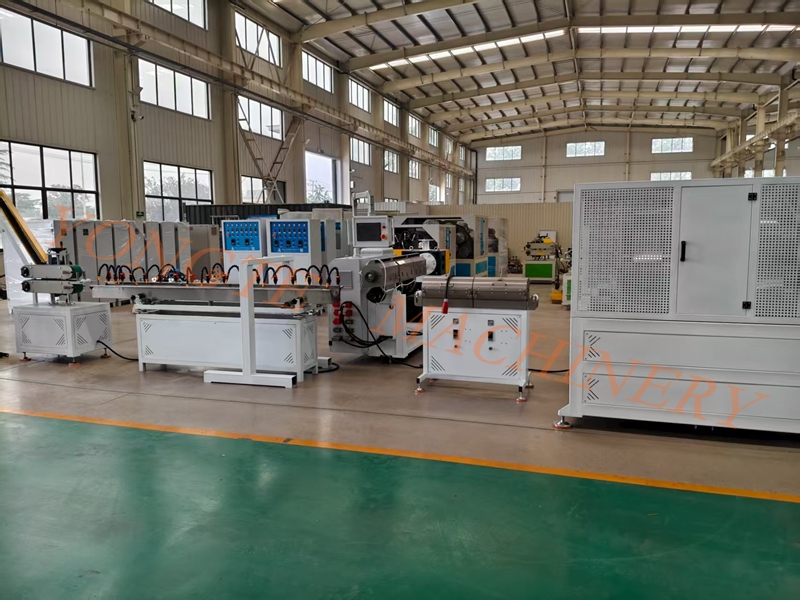Yongte PVC fiber pipe production line: hit the pain point directly, drive industry upgrade
PVC fiber reinforced hose, this thing is too common in our industry, agriculture and daily life. It has both the corrosion resistance of PVC itself and the fiber layer inside to support the "bones", which is both flexible and durable. Think about it, the integrated irrigation of water and fertilizer in the fields cannot do without it to stably deliver low-concentration fertilizer and pesticide water; in the factory workshop, it can also handle the low-pressure transmission of cooling water, lubricating oil and even compressed air; temporary water supply and drainage, ventilation and dust removal on the construction site, it can still handle it. Not to mention the daily chores of watering flowers, connecting equipment, and cleaning the courtyard at home, even special fields such as aquaculture and light industrial packaging can see its presence. It can be said that this "soft and hard" pipe has a really wide range of applications.
At present, agricultural modernization, industrial automation, and urbanization construction are all accelerating, and the demand for PVC fiber pipes is naturally rising. Agricultural irrigation needs to be upgraded, requiring more durable water hoses; industrial production pursues precision, and the performance requirements for fluid delivery pipes are also higher; the popularization of household equipment has broadened its application scenarios. The market prospects are obviously very good.

But to be honest, it is not easy to make this kind of pipe well and stably. People in the industry know that there are many "roadblocks" hidden here:
The raw material level is not easy to pass: The PVC base material formula is like a little ancestor. If the proportion of plasticizers, stabilizers and other additives is slightly worse, the performance may be off. What's more troublesome is that the performance of different batches of raw materials fluctuates. The formula adjusted today may not work tomorrow. The same is true for fiber-reinforced materials. Unstable strength or inadequate surface treatment directly drags down the quality of the finished product.
Fiber layer molding is a technical job: Should the weaving density and tension be uniform? Should the weaving angle be precise? Should the fiber layer size be stable? It sounds simple, but there are pitfalls everywhere. If the control is not good, the axial and radial strength of the pipe will not meet the requirements.
The compounding process is prone to "two skins": PVC and the fiber layer must be tightly "hug" together to be successful. However, if the molten PVC wants to evenly infiltrate the fiber layer, the temperature, pressure, and pulling speed must be perfectly matched. A slight mismatch may lead to poor bonding and the hidden danger of delamination.
Cooling and shaping require timing: Fast or slow cooling, uneven or uneven cooling will produce internal stress, causing the pipe to deform or performance to be discounted. The precision and vacuum control of the shaping mold are directly related to whether the pipe diameter is accurate and the surface is smooth.
Quality stability and defect control are difficult: Online detection methods are limited, and equipment precision requirements are high. If you are not careful, defective products will slip by. Coupled with the pressure of environmental compliance (such as VOCs emissions, wastewater treatment, and energy consumption control), the burden of this production line is not light.

In the face of these real industry pain points, Yongte Plastic Machinery's PVC fiber pipe production line provides a set of hard-core solutions to hit the key points:
Deal with "unstable formula and raw material fluctuations"? We have "eagle eyes" + "smart brain": precision batching system takes the lead, and automated metering keeps the error of raw material ratio within ±0.1%, completely saying goodbye to manual error. Raw materials enter the factory first through "security inspection" (online spectral detection), and those with unqualified purity are directly "rejected". This is not enough, the system can also dynamically fine-tune the formula based on data, no matter how the raw material batches change, the performance of the tubes produced is stable.
Overcoming the "fiber layer weaving problem"? It depends on the word "stable": The advanced tension control system on the weaving equipment is the key. It can firmly stabilize the tension of each fiber yarn, and the woven mesh is uniform and dense, with precise angles, ensuring that the tube is "hard" enough in the axial and radial directions. The high-precision detector keeps an eye on the size of the fiber tube blank throughout the process. If there is any sign of something wrong, the automated equipment will immediately make adjustments to lay a good foundation for the subsequent uniform PVC coating.
Solve the problem of "poor bonding between PVC and fiber layer"? "Activation" + "precision control" two-pronged approach: We carry out special "activation treatment" on the fiber layer, which is equivalent to applying a layer of strong "glue" between it and PVC, so that the molecular chain can be more firmly combined. The special composite mold ensures that the molten PVC evenly wraps the fiber layer like "coating". Extrusion temperature, composite pressure, traction speed? These key parameters are precisely controlled to make the two truly integrated. The online bonding force detection device "checks the pulse" in real time, and the data feedback control system automatically adjusts the bonding force to meet the standard before it is released.
Breaking "cooling shaping deformation"? "Uniform cooling" + "precision shaping" is the key: The optimized cooling system ensures that the temperature and flow rate of the cooling medium are uniform everywhere, and the internal stress is strangled in the cradle. The shaping mold and the cooling system work well together, and the vacuum degree is controlled just right, so that the hose fits tightly to the inner wall of the mold during cooling, and the pipe diameter accuracy and surface finish are naturally guaranteed.
Improve "quality stability and defect detection"? "AI quality inspection" + "online pressure test" show their prowess: The production line is equipped with an "Eagle Eye" system - visual inspection based on AI algorithms, surface defects are nowhere to be found. Coupled with the online water pressure burst test, the pressure resistance performance is verified on the spot. Once the "problem element" is found, it is automatically eliminated without mercy, and the scrap rate is forced to be less than 1%.
Ensure "equipment accuracy and less downtime"? "High-precision collaboration" + "predictive maintenance": The entire line of equipment adopts a high-precision frequency conversion control system, with uniform movements and precise speed matching. Consumable parts? They are made of real materials. The equipment operation status monitoring system is even more prepared, with early warning before the failure occurs, minimizing downtime, and naturally increasing production efficiency.
Dealing with "environmental compliance pressure"? "Green production" runs through the whole process: Start from the source, use environmentally friendly additives, and ensure that the product itself meets the standards. Waste gas and waste water in the production process are not spared. The perfect waste gas treatment system allows the VOCs removal rate to exceed 95% steadily, and the recycling rate of cooling waste water is as high as more than 80%. Energy-saving equipment is standard, and the unit energy consumption is reduced, truly realizing green and efficient production.

In short, Yongte Plastic Machinery's PVC fiber pipe production line is not a simple equipment stacking, but an "overall solution" created with a series of innovative technologies and intelligent means to target the core pain points of the industry. It has really solved the production problems, improved product quality and stability, and also controlled the environmental protection checkpoint, injecting a strong and reliable driving force into the high-quality and sustainable development of the PVC fiber pipe industry.